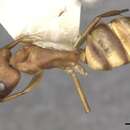en
names in breadcrumbs


Taxonomic history
Emery, 1906c PDF: 188 (q.); Solis et al., 2010 PDF: 265 (l.).Combination in Camponotus (Myrmoturba): Bruch, 1915 PDF: 535.Combination in Camponotus (Tanaemyrmex): Emery, 1925d PDF: 81.Subspecies of Camponotus fumidus: Santschi, 1922d PDF: 101.Raised to species: Snelling, 1968b PDF: 351.
Camponotus vittatus is a species of carpenter ant and one of the most common ants found around households in South America, particularly Brazil. It was originally described by Auguste Forel in 1904.[1] The species is relatively large, caramel-coloured, omnivorous,[2] and fast-moving. The species presents four larval stages which will spin a cocoon to pupate.[3] The hairs of Camponotus larvae are quite abundant, and may present taxonomic importance.[3][4] The larvae of both sexes are similar, with few diagnostic traits, such as the acquired shape towards pupation inside their cocoons.[5]
Camponotus vittatus is a species of carpenter ant and one of the most common ants found around households in South America, particularly Brazil. It was originally described by Auguste Forel in 1904. The species is relatively large, caramel-coloured, omnivorous, and fast-moving. The species presents four larval stages which will spin a cocoon to pupate. The hairs of Camponotus larvae are quite abundant, and may present taxonomic importance. The larvae of both sexes are similar, with few diagnostic traits, such as the acquired shape towards pupation inside their cocoons.